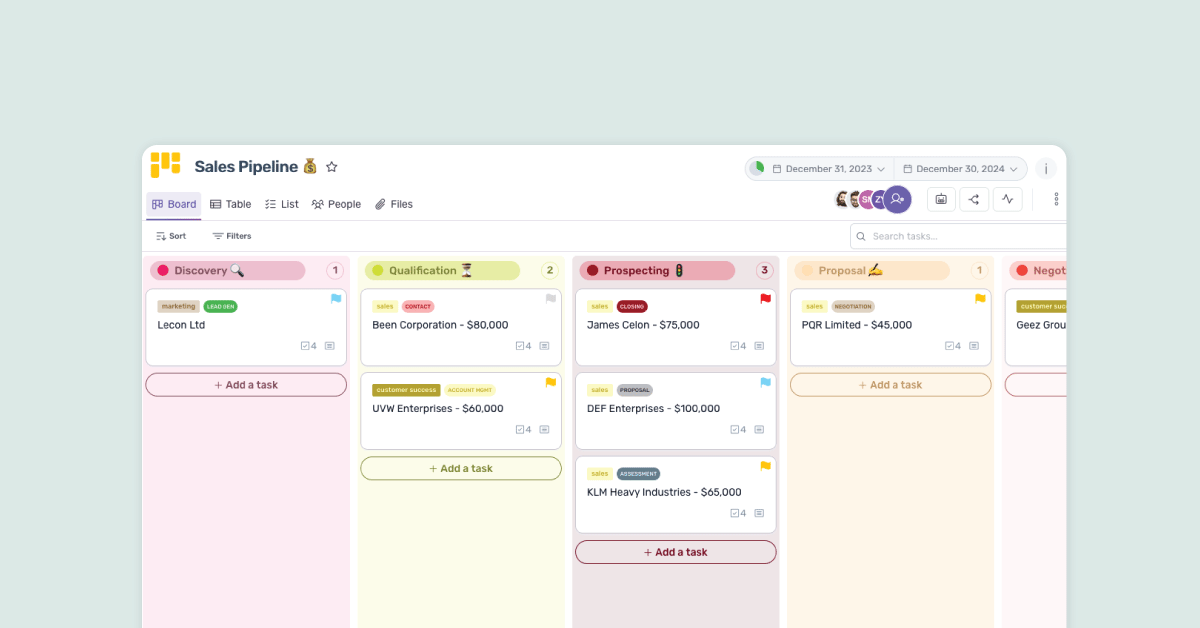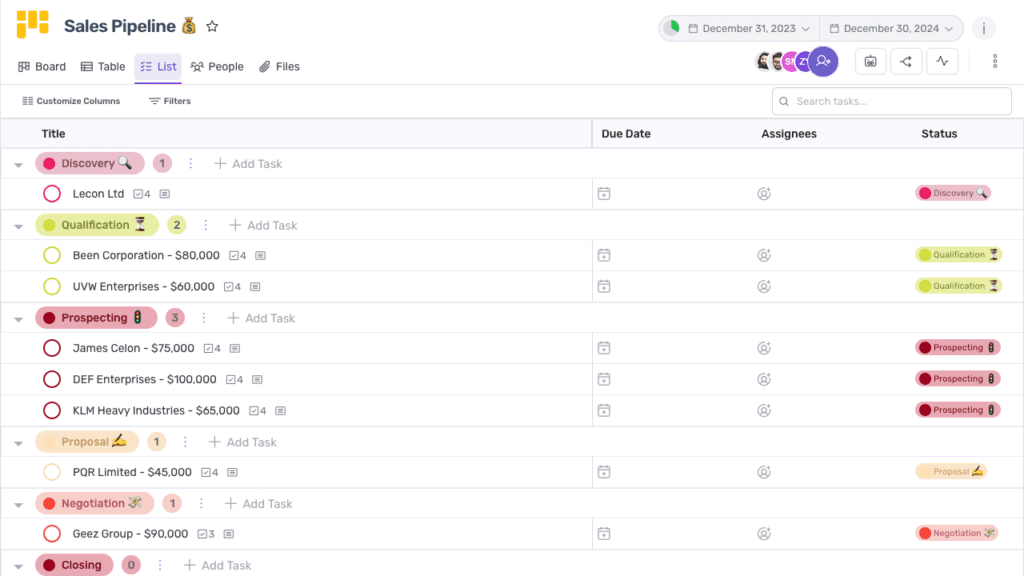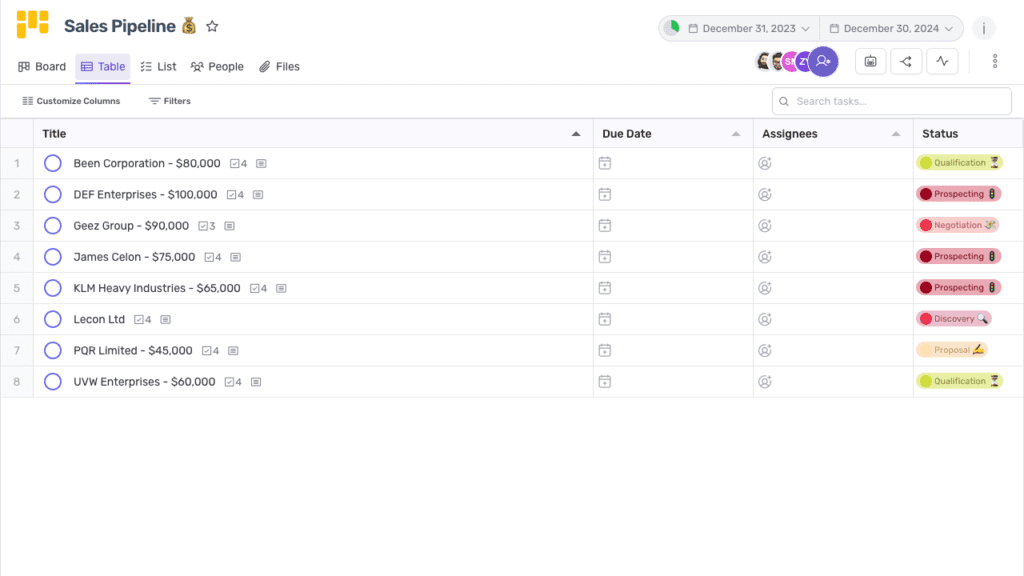LIMITED TIME OFFER
Replace all of these

with a single tool for just $1 per month for your entire team
UNLIMITED USERS
UNLIMITED PROJECTS
UNLIMITED CHATS
UNLIMITED DOCS
UNLIMITED STORAGE
AND MORE..
Streamline Your Sales Pipeline Project with This Template

A streamlined sales pipeline can make all the difference. By efficiently managing your sales process, you can maximize revenue and achieve sustainable growth. It is crucial to have a clear understanding of the importance of a streamlined sales pipeline and the key components that contribute to its effectiveness. In this article, we will explore the benefits of using a sales pipeline template and provide you with step-by-step guidance on how to streamline your sales pipeline using our template. Additionally, we will touch on maintenance and updating strategies, offer tips for maximizing efficiency, and conclude with a recap of the impact a streamlined sales pipeline can have on your business.

Understanding the Importance of a Streamlined Sales Pipeline
A sales pipeline plays a pivotal role in the growth and success of any business. It provides a visual representation of the sales process and allows you to track and manage your leads at every stage. By streamlining your sales pipeline, you can ensure that your sales team is focusing on the right opportunities, resulting in increased conversions and improved revenue. A streamlined sales pipeline eliminates bottlenecks, reduces the sales cycle, and enables better forecasting to drive business growth.
Moreover, a well-structured sales pipeline not only enhances the efficiency of your sales team but also fosters better communication and collaboration within the organization. It serves as a central hub where sales data is consolidated, analyzed, and utilized to optimize strategies and tactics. By fostering a culture of continuous improvement, a streamlined sales pipeline can adapt to market changes and evolving customer needs, ensuring long-term success for the business.
The Role of a Sales Pipeline in Business Growth
A well-designed sales pipeline acts as a roadmap for your sales team, guiding them through the sales process from lead generation to customer acquisition. It helps identify potential roadblocks and allows for proactive problem-solving. By analyzing the data within your sales pipeline, you can identify trends, understand customer behavior, and make data-driven decisions to fuel business growth.

Furthermore, a robust sales pipeline serves as a valuable tool for benchmarking and performance evaluation. By setting clear metrics and KPIs within each stage of the pipeline, businesses can track progress, identify areas for improvement, and celebrate successes. This data-driven approach not only motivates the sales team but also provides valuable insights for strategic planning and resource allocation.
Key Components of an Effective Sales Pipeline
An effective sales pipeline comprises several key components that work together to streamline the sales process. These components include lead generation, lead qualification, sales opportunities, sales stages, deal closure, and post-sale activities. Each component serves a unique purpose in managing the sales cycle and aligning your efforts with the needs of your customers.
Moreover, integrating automation and technology into your sales pipeline can further enhance its effectiveness. By leveraging CRM systems, analytics tools, and communication platforms, businesses can automate repetitive tasks, gain real-time visibility into sales activities, and personalize interactions with customers. This technological integration not only improves efficiency but also enables sales teams to focus on building relationships and providing value, ultimately driving business growth and customer loyalty.
Introduction to Sales Pipeline Templates
Now that we understand the importance of a streamlined sales pipeline, let’s dive into the concept of sales pipeline templates.
Establishing a well-defined sales pipeline is crucial for the success of any business. It not only helps in organizing and managing leads but also provides a clear roadmap for converting prospects into customers. Sales pipeline templates play a pivotal role in this process by offering a structured framework that guides your team through each stage of the sales cycle.
What is a Sales Pipeline Template?
A sales pipeline template is a pre-designed framework that provides a visual representation of your sales process. It serves as a guide for your sales team, ensuring consistency and efficiency in their approach. The template outlines the various stages of your sales cycle and helps you track the progress of each lead. By using a sales pipeline template, you can simplify your workflow, standardize procedures, and improve communication within your team.
Furthermore, sales pipeline templates can be customized to align with your specific business requirements. Whether you operate in a B2B or B2C environment, tailor-made templates can be created to suit the unique characteristics of your industry and target audience. This level of customization enhances the effectiveness of the template and ensures that it resonates with your team’s workflow.
Benefits of Using a Sales Pipeline Template
Using a sales pipeline template offers numerous benefits for your business. Firstly, it provides a clear and structured overview of your sales process, making it easier for your team to understand and follow. Secondly, it facilitates effective communication among team members, ensuring everyone is on the same page. Additionally, a template allows for easy tracking and analysis of sales data, enabling you to identify areas for improvement and optimize your strategies. Overall, a sales pipeline template saves time, enhances productivity, and leads to better decision-making.
Moreover, the visual nature of sales pipeline templates can aid in identifying bottlenecks or areas of inefficiency within your sales process. By visually mapping out the journey from lead generation to conversion, you can pinpoint where leads are getting stuck or dropping off, allowing you to implement targeted solutions to improve conversion rates. This analytical approach can significantly boost your sales performance and drive revenue growth.
Steps to Streamline Your Sales Pipeline Using Our Template
Now that you realize the value of a sales pipeline template, let’s dive into the steps to streamline your sales pipeline using our template.
But first, let’s take a moment to understand why streamlining your sales pipeline is crucial for your business. A well-optimized sales pipeline can help you increase efficiency, improve customer relationships, and ultimately boost your revenue. By implementing our template, you’ll have a structured framework that guides your sales team through each stage of the process, ensuring that no leads slip through the cracks.
Initial Setup of Your Sales Pipeline Template
The first step is to set up your sales pipeline template according to your business requirements. Determine the stages of your sales cycle, such as prospecting, qualification, proposal, negotiation, and closure. But don’t stop there – take the time to analyze your current sales process and identify any bottlenecks or areas for improvement. By doing so, you can tailor the template to address these specific pain points and create a streamlined workflow that maximizes productivity.
Additionally, consider involving key stakeholders from different departments in the initial setup. Their insights and perspectives can provide valuable input and ensure that the template aligns with the overall goals and objectives of your organization.
Customizing the Template to Fit Your Business Needs
Once you have the initial setup in place, it’s important to customize the template further to match your business needs. Tailor the fields, labels, and other elements to reflect the terminology and metrics relevant to your industry. This level of customization not only enhances user experience but also facilitates seamless integration with your existing CRM or sales management tools.
Moreover, consider incorporating automation features into the template. Automation can save your sales team valuable time by automating repetitive tasks, such as sending follow-up emails or updating lead statuses. By leveraging technology to its fullest potential, you can empower your team to focus on building relationships and closing deals.
Tracking and Analyzing Sales Data with the Template
As your sales team starts using the template, diligently track and log all relevant sales data. Monitor the progress of each lead, update the status as they move through the pipeline, and record any interactions or activities. But don’t just stop at data entry – take advantage of the analytical capabilities of our template.
By consistently tracking and analyzing sales data, you can identify trends, evaluate the effectiveness of your sales strategies, and make informed decisions to optimize your pipeline. Look for patterns in lead conversion rates, identify the most successful sales tactics, and pinpoint areas where your team may need additional training or support. Armed with this valuable information, you can continuously refine your sales process and stay one step ahead of the competition.
So, are you ready to take your sales pipeline to the next level? With our template and these steps, you’ll be well on your way to achieving sales excellence and driving sustainable growth for your business.
Maintaining and Updating Your Sales Pipeline Template
Streamlining your sales pipeline is not a one-time task. To ensure maximum efficiency, you must regularly review and update your sales pipeline template.
Creating a seamless sales pipeline template is crucial for the success of your sales team. It serves as a roadmap for your sales process, guiding your team from lead generation to closing deals. However, simply creating a template is not enough. Regular maintenance and updates are essential to keep it relevant and effective in a dynamic business environment.
Regular Review and Update of Your Sales Pipeline
Set a cadence for reviewing and updating your sales pipeline template to reflect any changes in your business environment, target audience, or sales process. Analyze the data within the template, identify areas for improvement, and make necessary adjustments to optimize your pipeline. Regularly reviewing and updating the template will ensure its ongoing relevance, effectiveness, and alignment with your evolving business goals.
Moreover, by regularly reviewing your sales pipeline template, you can identify trends, patterns, and bottlenecks in your sales process. This data-driven approach allows you to make informed decisions on how to enhance your pipeline and drive better results.
Adapting the Template to Changing Business Goals
Business goals are ever-changing, and your sales pipeline template should be adaptable to those changes. As your strategies evolve, modify your template to reflect new objectives, priorities, or target markets. By aligning your sales pipeline template with your changing business goals, you can ensure that your sales efforts remain focused and effective.
Furthermore, adapting your sales pipeline template to changing business goals enables you to stay ahead of market trends and competitors. It allows you to pivot quickly in response to new opportunities or challenges, ensuring that your sales strategy remains agile and responsive.
Tips for Maximizing the Efficiency of Your Sales Pipeline Template
While using a sales pipeline template is a great start, there are several best practices you can follow to maximize its efficiency.
One key aspect to consider when aiming to maximize the efficiency of your sales pipeline template is the importance of data accuracy. Regularly reviewing and updating your pipeline is crucial to ensure that the information within it remains relevant and reliable. By keeping your data up-to-date, you can make more informed decisions and better track the progress of your sales opportunities.
Best Practices for Sales Pipeline Management
Regularly review and update your pipeline to ensure accuracy and relevance. Set clear milestones and goals for each stage to keep your team focused and motivated. Foster open communication among team members to facilitate collaboration and problem-solving. Lastly, leverage technology and automation tools to streamline your pipeline further and improve workflow efficiency.
Another important best practice for effective sales pipeline management is the establishment of a feedback loop. Encouraging team members to provide feedback on the pipeline template can help identify areas for improvement and ensure that it remains aligned with the evolving needs of your sales process. By incorporating feedback from those directly involved in using the template, you can continuously refine and optimize its effectiveness.
Avoiding Common Pitfalls in Sales Pipeline Streamlining
When streamlining your sales pipeline, there are common pitfalls to avoid. Don’t overload your pipeline with too many stages or unnecessary complexity. Ensure that your team is properly trained and equipped to utilize the template effectively. Lastly, establish clear guidelines and expectations to maintain consistency and accountability within your team.
Furthermore, it is essential to monitor the performance of your streamlined sales pipeline regularly. By tracking key metrics and analyzing the effectiveness of your pipeline modifications, you can identify any bottlenecks or inefficiencies that may arise. This data-driven approach allows you to make informed adjustments and continuously optimize your sales pipeline for maximum efficiency and productivity.
Conclusion: The Impact of a Streamlined Sales Pipeline on Your Business
A streamlined sales pipeline has a substantial impact on the overall success of your business. By implementing a sales pipeline template, you can optimize your sales process, increase conversions, and foster sustainable growth. A streamlined pipeline allows your team to focus on high-value prospects, efficiently move leads through the sales cycle, and make data-driven decisions to improve outcomes.
Recap of the Benefits of a Streamlined Sales Pipeline
In summary, a streamlined sales pipeline offers benefits such as improved efficiency, enhanced communication, better forecasting, and increased revenue. By leveraging a sales pipeline template, you can enjoy these benefits and secure a competitive advantage in the market.
Next Steps in Implementing Your Sales Pipeline Template
Now that you have gained insights into the importance of a streamlined sales pipeline and how to implement it using a template, it’s time to take action. Evaluate your current sales process, identify areas for improvement, and integrate our sales pipeline template into your workflow. Remember, continuous improvement is key, so regularly review and adjust the template to meet the changing needs of your business.
With a streamlined sales pipeline and our template as your guide, you are well-equipped to enhance your sales process, drive business growth, and achieve long-term success.
Take the Next Step with Teamhub
Ready to elevate your team’s collaboration and streamline your sales pipeline? Start your free trial with Teamhub today and experience the power of a centralized hub for your Projects and Documentation. Join the thousands of companies enhancing their productivity with our intuitive platform. Start your free trial and transform the way your team operates!


